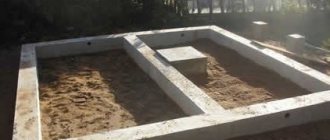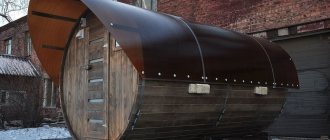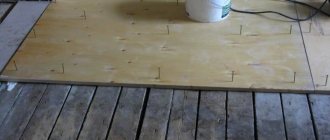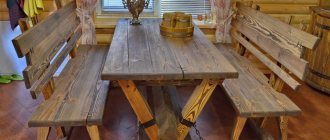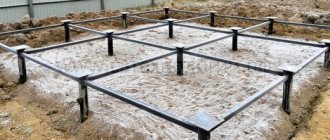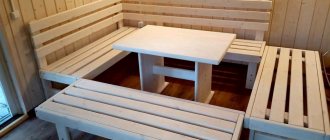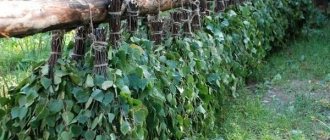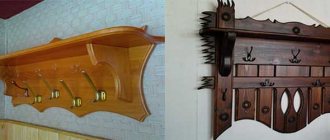Each bathhouse for bathing procedures must be equipped with the necessary accessories. But not everyone knows what to choose - will a metal, plastic or wooden sauna ladle be best? We will consider this question in detail.
Traditional accessories for bath procedures in Rus' were made of wood.
>
Distinctive features of the bucket and scoop
Despite the similarity of shape, the ladle and scoop have their own distinctive features. The sauna ladle performs several tasks:
- pour cold and hot water into bath containers;
- contrast body wash.
The most important requirement when choosing is the material. The best approach is natural wood. This product does not lose its shape and does not allow liquid to pass through. A special difference between the material is the aroma of wood. Natural raw materials emit a charming smell that relaxes the body and purifies the air.
It is possible to buy a plastic bucket. But it should be remembered that hot temperatures cause the plastic mass to deform; at high temperatures or in contact with hot objects, it may simply melt.
Another option is metal. They are dangerous to use in a bathhouse: you can easily get burned from the heated metal.
In the photo - a metal scoop for a bath
Among modern trade offers there are combination options. You can find a metal ladle with a wooden frame and a solid wood handle. Such an item for a steam room will be very convenient. Metal, even if cracks appear on the wood, will not allow hot liquid to spill out. You can take it by the handle and not be afraid of burns.
A sauna scoop performs slightly different tasks: it waters the stove stones and adds heat to the steam room. The freshness and amount of steam depends on the scoop. Fans of the Russian refreshing procedure are advised to opt for wooden attributes. An oak and linden sauna ladle will create an amazing microclimate of clean and fresh air.
What can be replaced
Traditional wooden scoops can be replaced with hybrid scoops, inside of which there is a metal container. Such buckets are convenient, durable and practical, but their price is higher than their classic solid or composite wooden counterparts.
After the first use of the ladle, it should be washed using soda, mustard and scalded with boiling water.
As an alternative to wooden ladles for a bath, you can consider ladles made of high-strength heat-resistant plastic. Despite their durability and sufficient reliability, such models cannot be classified as aesthetic products.
True lovers of the Russian steam room still prefer wooden products. Cooperage or carved scoops made of natural wood have always been highly valued for their original appearance, practicality and pleasant aroma of Russian forest.
Types and forms of wooden products
Wood is the traditional and most popular material for making ladles. Most often they choose linden, oak, aspen, cedar, and mulberry. Their wood is not afraid of moisture and can withstand high temperatures. Finished products are coated with liquid wax or a layer of mala flax.
carved
They are made from a single piece of wood. They look in the style of antique utensils and will be ideal for creating coziness and comfortable conditions.
Bondarnye
They are made from separate planks pressed tightly against each other. The technology is close to the creation of barrels. The planks hold their shape for a long time; if they dry out, cracks and cracks may appear. But it is not difficult to return to the desired shape. The ladle is soaked in water. The tree swells and the cracks disappear.
Carved ladle for bath
You can make a scoop with your own hands. For this, wood and a carpenter's set of tools are prepared. On paper you need to draw the appearance of the future product, a simple sketch. Then decide on the dimensions and complete the drawing. It is better to first consider the remaining actions in the video lesson of the masters. Then start working on your own according to the steps described below.
- Draw contours according to the dimensions on the tree.
- Rough processing is being carried out.
- A handle and container are formed.
- Then the interior sides of the bowl container and the handle are finished.
- If skillful, it can be decorated with patterns or decorative carvings.
Rules for choosing bath assistants
In the washing room and steam room it is better to have both products: a ladle and a ladle. They should be in a convenient place, on special hooks and holders. There should be no obstacles to pick them up, take them out or remove them. Choose an open and accessible place. The choice should be based on the area of the entire building, the internal distribution of areas, and the material used.
Particular attention should be paid to the location of the heater. The best option is to have several different buckets and scoops. The reason for this is that most often they wash not one at a time, but together or in a group. Several assistants will not delay the procedure for receiving pleasure. You won't have to wait for the bath ladle to become empty.
The scoop is selected according to the length of the handle. If the stones are nearby and closed with special flaps, the handle may be small. If the stones are open, close to the tank, you need to take a long handle. It is dangerous to throw steam with a short handle; you can get burned by the steam.
To choose a bucket or scoop, you need to know their features
The shape of the handle is made to fit the curve of the palm, for gripping with the hand. Its thickness matters. Therefore, one ladle is made for women, another for men. Small ladles for children. Splashing and steaming with your own ladle will not only be pleasant, it will become a kind of education for the child and preparation for understanding the whole essence of visiting a Russian bathhouse, a step towards adulthood.
Other handle sizes:
- The water scoop should have a long handle, this will be convenient for collecting water from a distance;
- The product is of medium length for pouring; it is convenient to pour while standing, sitting and lying down.
This lesson was provided to us by a MASTER from the city of Syzran. It tells in detail (and shows - so far the largest master class on the site - more than 30 photos) how to make a beautiful ladle-mug from a log.
So, first we take a log and cut it into ridges of the required length. This can be done conveniently using a gas or electric saw.
We split it into two “equal cotyledons”. We draw out the working plane with a hatchet, if this is necessary, of course. We draw the contours of the future vessel on it and begin to remove excess material with it, first roughly.
You can (and should) in some places, for example, at the ends, use a hacksaw, jigsaw, or better yet, a band saw (if you have one, we don’t have one yet)
We file the handle, leaving an allowance, and chop it off with an ax. Dangerous moment! If the fibers don’t go straight, you can even chip off half the scoop!
Finer removal of material is done using semicircular chisels.
On the resulting side profile we draw the contours of the handle and scoop.
And one more shot illustrating both projections.
Let's move on to processing the handle. Using the same chisels, we roughly remove the material, adjusting it to the contour.
select a hole using cranberries
What is not convenient to cut with a chisel is removed with a knife
Now you need to connect the contours on the bottom and body. To do this, draw another contour of the narrowing of the bottom.
I did it with an axe, you could use a knife or a chisel, it doesn’t matter
Using a sharp knife, we remove all irregularities, angularities, etc., rounding off the shapes.
We do this until it looks like this.
Let's move on to choosing a bowl. To speed up the process, we’ll use 35 mm. The main thing here is not to drill through.
Next, using a power chisel and mallet, we chop off the main mass inside. The chisel, like many of my tools, is homemade. I forged it from a spring, hardened it, and that’s how I use it. Fully working
Gradually remove the material from the scoop.
We take a narrower chisel and continue working.
Using cranberry we go deeper into the bottom, cutting off the flat part formed by the cutter.
We evenly select the material until it reaches this state: the walls are slightly translucent, the thickness should be left approximately 5-6 mm with an allowance for further polishing
Here is a general view of the intermediate product.
We turn the ladle over and select a recess on the bottom so that it does not rock on the table.
We remove everything unnecessary and this is what we have at the end of the first part. We URGENTLY wrap it in newspapers and a bag, otherwise it will crack!!! Let it dry. Then there will be sanding.
That's it, drying is complete. Let's start sanding
Let's start sanding the inside with this homemade device.
This is how it happened after 7-10 minutes of work, during the process I changed the sanding wheel twice. But you still need to work with your hands!
Now let's sand the outside. A belt sander makes life so much easier!
We run the bucket from all accessible sides, with a belt up to 80.
after processing with 80th tape it turns out like this.
Now with your hands! Using sandpaper of the same grit, we smooth out the remains and then clean it with a finer one until smooth.
Then we wet it with water. Raise the pile and sand again, gradually reducing the grain size.
It’s convenient to use this sponge for this. I repeated the process 4 times, the result was satisfactory. You can do more, you won’t ruin the ladle with sandpaper!
Now the impregnation. I use regular flaxseed from the pharmacy. Some people recommend special bleached flaxseed oil, I have not tried it yet. First we pour it inside.
Oil appears at the ends literally before our eyes! Next, I thickly lubricate the entire surface and leave it in the sun until absorbed, then repeat the process.
Soaked it three times. Then I melt the wax in a water bath and apply it with a brush. Then I warm up the mug (without fanaticism!!!) to absorb the wax, wipe it with a dry cloth and that’s it. (stormy applause turning into standing ovation)
Bath accessories are accessories without which the steam room cannot be called fully equipped and comfortable. Thanks to stylish and comfortable items, it becomes possible to create a special cozy atmosphere. These include hats, brooms and much more. Anyone can make bath accessories with their own hands.
The production of accessories for equipping a bathhouse has now reached a new level. The variety of products offered by a large number of firms and companies can surprise even the most demanding buyer. However, most people prefer accessories that are made by hand. And this is not surprising, because they look beautiful and are practical to use.
Make your own wooden bucket
What is a bathhouse without a wooden bucket with cool or warm water? It is impossible to imagine a steam room without this important device. To make it yourself, you first need to decide on the type of wood. It is known that the strongest and highest quality species is oak, but if due to certain reasons it cannot be used, then you can use ash or mulberry. Do-it-yourself bathhouse accessories are often made from them.
The boards used to make buckets are called staves. When selecting them, it is recommended to ensure that there is a distance between the ears of exactly half the perimeter. Then the product will be convenient to use. The ears should be as long as possible. This eliminates the possibility of the temples splitting. An incorrectly worn wire shackle can cut your hand, so to make the accessory safe, you need to put a handle made of wood on the shackle.
The bucket handle is made of steel wire, the thickness of which is more than 7 mm. A bail taken from an old bucket will work perfectly. However, before you start using it, you need to carefully remove all traces of rust from it.
Purpose of the headrest
Thanks to the presence of shelves and benches located in one or several rows, you can enjoy the heat in the steam room while lying down, and for greater convenience, add a removable sauna headrest made of wood. This accessory, shown in the photo, serves as a pillow.
Procedures taken in a lying position have a positive effect on the condition of the spine and muscles, relaxing them. When using this accessory, which is placed under the head in the bathhouse, the positive effect of visiting the steam room is enhanced. It can be straight, round or curved.
Instructions
DIY bath bucket, instructions:
- After selecting and processing the material, it is necessary to determine the volume of the product. It can be anything, but not less than ten liters;
- Now you need to calculate approximately how many rivets will be required for the selected size of the future bucket;
- Then you need to process the rivets and give them the desired shape. Since ancient times, these boards have been made wider at the ends than in the central part. This simple tip will make assembling the accessory much easier;
- To make a bucket you will definitely need hoops. They can be made from wood, which look impressive, or from metal, which is superior to the previous material in terms of strength;
- The next step is to decide on the diameter of the hoops and decide how many of them will be needed. The minimum number of rings is two, one at the bottom, the other at the top;
- Now you can start assembling. To the hoop with the smallest diameter, three rivets must be attached at equal distances using clamps. Then you need to carefully fill all the remaining space between them with other boards;
- Particular care must be taken when inserting the last element. If he doesn’t have enough free space, then there’s nothing wrong with that. It is enough just to trim it a little, then insert it;
- To attach the bottom of the bucket, the wood must first be steamed in hot water. To do this, place the circle in boiling water for thirty minutes;
- Next, the almost finished bucket needs to be turned over, and a rope needs to be thrown over the loose edge of the product. It is recommended to tie its ends to a hook, which must be installed in any safe place. After this, a piece of metal needs to be inserted between the bundles and begin to pull it towards you;
- After tightening, you can fasten the remaining hoops;
- When installing the bottom, you need to use metal clamps.
To prevent self-made buckets from deteriorating over time, it is recommended that you familiarize yourself with the following tips:
- Wood is the main production material. It can crack and develop plaque and mold over time. To prevent such troubles from happening to your products, you need to steam them with hot water every time, then you need to select the buckets dry and remove them further from the fire. This is not very difficult, but it will protect the products from damage;
- If you have not used containers made of wood for a long time, they will gradually lose their tightness. Therefore, before starting bath procedures, you need to pour cold water into them and leave them in this state for the next three to four hours. Because of this, the material will swell and small cracks will disappear on their own. When finished, the water should be poured out and the bucket itself should be scalded with boiling water for disinfection purposes.
To supply water in the bathhouse, you need to use a special wooden ladle. Only this will help you carefully pour water onto the heater in small portions and not burn your hands. To ensure that the bucket not only copes with its tasks, but also looks attractive, you can make this accessory yourself. It won’t take much time, but you will significantly decorate your bathhouse and make it several times more functional.
The first step is to decide on the wood from which the bucket will be made. It could be:
- Oak is the most popular and sought-after type of wood, famous for its strength characteristics. This one differs from other types of wood in its rich color and attractive appearance;
- Ash is a light-colored wood with a pleasant aroma. It is perfect for making a ladle, since it is not afraid of temperature changes that are constantly present in the steam room;
- Mulberries are the last type of wood that is recommended to be used for making bath accessories. She doesn’t care about exposure to moisture or humid air, so she can maintain her beautiful appearance for a long time.
After choosing the material, you need to prepare it. To do this, you need to dry the bars and give them the required shape.
Manufacturing process
DIY sauna ladle:
- After choosing the material, you need to decide on the dimensions of the future bucket. It should not be large, otherwise the water will be inconvenient and difficult to transfer. However, you should not make it too small;
- The next step is to find cardboard, draw three templates on it (for the sides, bottom and top of the accessory), cut them out;
- Then, using them, you need to mark the outline of the end on the wood. After this, carry out rough cutting of the product;
- Next, you need to do the same thing, but only for the top and sides. Try to give the resulting workpiece the shape characteristic of a ladle;
- The next step is to process the workpiece using a round chisel. This stage includes removing excess wood, forming a handle;
- Afterwards, you need to process the inside of the product using an adze. Once again work out its walls with a large chisel;
- Next, you need to shape the handle and the entire product with a special knife, cut out parts to decorate the tail and head of the accessory. Using cranberry, treat the inner surface;
- Now you can start sanding the product. First, sand the outer side of the product, and then proceed to the inner part. There is no need to grind the surface on which you plan to make the carving;
- Using small chisels you can cut out a finishing pattern;
- The last step of the job is to cover the surface with a layer of wax, which acts as protection.
It is worth noting that traditionally, ladles for use in Russian baths were carved only from wood. Several varieties of products stood out: Moscow, Novgorod, Suzdal. They all differed from each other in design and general design. For example, Moscow ones have always been made only from burl, which has a beautiful texture. Tver men made ladles from tree roots.
It is not difficult to make accessories for a bathhouse with your own hands. Despite this, they will look beautiful, please the eye, attract attention and amaze with their functionality and convenience.
Carrying out health procedures in the steam room is impossible without bath accessories. In particular, to perform douches or create steam, you must have a ladle. This accessory can be purchased at a special store or made independently.
Types and material of sauna ladles
There are models of different sizes and shapes. Buckets are classified according to the type of holder:
- With vertical handle
. Suitable for scooping water from a boiler. - With horizontal handle
. Used for dousing. In the absence of a ladle, such a ladle can be used to supply water or a decoction of herbs to the heater.
Usually the bucket holders are long.
This is necessary for ease of dousing, and also to avoid getting burned by the steam if you have to pour water onto hot stones. According to the type of container, buckets are:
- Carved
. They are cut from logs. Such models look aesthetically pleasing, but require special care. In particular, a wooden sauna ladle should not be left in a dry room, otherwise it will quickly begin to crack. To extend its life, it is recommended to fill it with water between uses and keep it wet. - Composite
. The capacity of such a ladle is a small “barrel” and has an original design. This model does not crack, but it must be stored in the same way as the previous one - in water. Otherwise the ladle will dry out.
Traditionally, these accessories are made using:
- Tree
. According to its performance characteristics, this material is optimally suited for use in a steam room. It is environmentally friendly and safe. However, the product requires careful care for a long service life. - Stainless steel or copper
. Practical and convenient metal buckets can be used and stored in any conditions. Their only drawback is that they get very hot. Metal products can cause burns. Therefore, most often, for safety reasons, such buckets are equipped with a wooden handle. - Plastic
. It is highly undesirable to use such models in a steam room. If the ladle is made of low-quality plastic, it may suddenly become deformed upon contact with hot water. Although polycarbonate products have high heat resistance.
You can purchase a ready-made production model or make a sauna ladle with your own hands.
Washcloths
There is a wide range of sets of bath accessories, which include brushes, washcloths, peeling stones, etc. If you want an original product that satisfies all your preferences, make it yourself.
A washcloth is necessary for body cleansing and wet massage. This procedure is not only pleasant, but also beneficial for the body. Sponges can be of different hardness, sizes and shapes. You need to choose a washcloth based on your personal tastes.
To knit a washcloth from natural materials, choose the wool of goats, sheep or any other farm animals. You can also use linen. The yarn for the washcloth must be thick, since the product itself is subject to mechanical stress, so choose the appropriate size of knitting needles or hook.
Most often, washcloths are knitted using the “checkerboard” or “tangle” pattern. The main part of the washcloth is knitted after the handle is ready. The handle must be tight, otherwise it will lose its appearance immediately after the first use. The product will not be so tough if you pour boiling water over it.
Features of choosing a bath ladle
You can purchase the finished product in a specialized store or order it online.
It is advisable to have several ladles in the bathhouse for different purposes:
- Several people can be in the steam room and washing area at the same time. It will be convenient if a bucket is provided for each vacationer.
- There should be a separate model with a long horizontal handle for supplying water to the stones.
- It is more convenient to draw water from the boiler with a ladle with a long vertical handle.
- For dousing in the wash compartment, a product with a medium-length handle is optimal.
It is recommended to give preference to safe wooden accessories. They will not be cheap, especially the models made by folk craftsmen. But you can be sure that they will not burn you when heated.
How to choose the right one
Wooden ladles look organic in a bathhouse; when heated, they convey a light aroma of wood
To avoid burns, bath scoops are made entirely of natural wood or metal, such as brass, copper or stainless steel. The main condition is the presence of a sufficiently long and necessarily wooden handle.
Depending on the functional purpose, bath scoops come in three main varieties:
- Models with vertical and long handles. Allows you to draw water from a tank that is not equipped with a tap, or from a barrel.
- Models with horizontal long handle. Designed for watering stove stones to regulate temperature and humidity levels in the steam room of the bathhouse. Thanks to the long handle, the risk of burns is completely eliminated.
- Models with short handle. Used for water procedures in the font. These scoops are lightweight and fit very comfortably in your hand.
Scoops for a bathhouse need to be selected in different sizes: for supplying water to the stones - with a volume of 0.2–0.3 liters, for collecting water - from 1 liter.
The range of such bath accessories is very diverse. Scoops differ in shape and volume, and have a variety of finishing options, including cutting and metal inserts. The main criteria for the correct choice of such an accessory are the ease of use of the scoop, its practicality and environmental friendliness, as well as aesthetics, safety and durability.
Technology for making a wooden ladle for a bathhouse
To make a sauna ladle yourself, you must initially decide on its size, length and position of the handle, material of manufacture, and type of container. Having chosen a model, it is advisable to initially make blanks from thick cardboard.
Selection of material for a sauna ladle
First of all, choose the type of wood you will use.
The best options for these purposes:
- Linden
. Practical wood with a pleasant aroma and original texture. Ideal for making all bath accessories. Does not rot or crack. Suitable for processing. - Oak
_ Strong and durable material. It has an interesting rich shade. - Ash
. Light and fragrant wood. Withstands large temperature changes. - Mulberry
. It is moisture resistant and durable.
To make a wooden sauna ladle with your own hands, it is recommended to use dry wood.
DIY carved sauna ladle
This method of making a bucket is considered simple, but it will require certain carpenter skills and a set of tools.
Decide on the type of wood and start processing. Let's look at how to make a carved ladle for a bathhouse:
- On thick cardboard we draw templates for the bottom of the bucket, its top and side walls. It should not be too large, as it will be difficult to carry when filled with water. However, if it is too small, you will have to draw water more often. The optimal size is up to two liters.
- We cut out the blanks and mark the edge contour lines on the wood with a pencil.
- We perform rough cutting.
- We mark the outline of the sides and top and make a cut according to the approximate outline of the bucket.
- We process the resulting workpiece with a round chisel and remove excess layers of wood.
- We form the handle of the product using a chisel.
- We process the inner sides with an adze and go through it again with a large chisel.
- Using a wood knife, we cut out the handle of the desired shape and the entire product. If you have artistic skills, you can make original patterns as decoration.
- The inside of the product is treated with cranberry.
- We sand the outer surface with coarse-grained paper and move on to the inner surface.
- Use chisels to cut out decorative patterns if desired.
How to make a composite ladle for a bathhouse
You can make such a model without any special cooperage skills.
To do this you will need a board, a handle, a base and a metal rim. We adhere to the following instructions during the process:
- Cut out a plank measuring 1 x 2.1 cm.
- We grind the sides at an angle of 12 degrees.
- We trim 15 parts, 8 cm each.
- We mill a groove along the bottom of all planks; its depth should be 0.4 cm and width 0.8 cm.
- We round off the sharp corners of the end sides. These will be the boards for the product.
- Let's prepare the handle. To do this, we use a planed board, the dimensions of which are 1.5x7.5x38 cm.
- We cut out the part into a convenient shape and round off the sharp corners.
- We drill a hole at the end with a diameter of 0.8-1 cm and thread a loop of rope into it.
- From a planed board 1x9 cm we cut out the base and grind the circumference to 0.6 cm, and to the radius - to 0.8 cm.
- We drill two through holes with a diameter of 0.4 cm in the main board. They will be used for fastening with sharp self-tapping screws with a pressed washer (0.4x2.5 cm).
- We assemble all the individual planks around the base, driving the bottom into the lower pre-made grooves.
- We compress the structure using twine.
- We prepare two hoops. To do this, we choose cold-rolled low-carbon, soft, steel packaging tape, measuring 0.4x0.2 cm.
- We make three holes in the prepared hoops with a diameter of 0.16 cm for construction nails 0.16x2.5 cm.
- We fill the first hoop from below at a height of 0.5 cm.
- We shorten the nails from 2.5 cm to 0.8 cm and attach the top hoop at a distance of 1 cm from the top edge.
- We fix the handle using self-tapping screws with a pressed washer.
- We lower the ladle into the water for a while.
After the wood swells, all the cracks will disappear. Such a product must be stored in water to prevent drying out.
Summary
The bathhouse is a great place to relax alone, with your family and a cheerful group of friends. However, in order for the bathhouse to be truly convenient to use, it must be equipped with a variety of accessories: hangers, buckets, lamps, etc. You can easily make all of the above and much more with your own hands from wood that is pleasant in its properties and easy to process.
Arriving at the bathhouse, the first thing you are faced with is the need to place your clothes. Nobody takes a steam bath dressed in the bathhouse! In a large rest room or dressing room, of course, you can put a full-fledged closet, but this is rarely done, because... free space can be taken up with much more interesting and useful things.
The best solution to storing clothes and other accessories while visiting the steam room is a beautiful wall hanger. To make this attribute, you do not need to have extensive experience in carpentry work. Just do everything according to the simple step-by-step guide.
First step. Prepare a template according to the desired hanger shape. This product can have a wide variety of appearances, but the manufacturing procedure always remains almost the same. The template can be made from paper and then quickly and easily transferred to wood. If you plan to make several identical hangers, it is better to make a template from plywood or any other thin board.
We suggest you familiarize yourself with How to ventilate the floor in a bathhouse
Second step. Decide how many hooks your hanger should have. Optimally - from 2 to 4. Mark the places for attaching the hooks and drill holes in accordance with the markings. Also prepare the holes with which the hanger will be fixed to the wall.
Third step. Saw the blanks to assemble the base of the hanger. So, for a hanger with 4 hooks, a base measuring about 50x10 cm and a thickness of 2-3 cm is enough. Attach the pre-prepared template to the workpiece and start milling using a rolling cutter.
If you don’t have a cutter, you can simply sand the edges of the workpiece. If desired, you can round the edges of the base or give them any other shape.
Fourth step. Make hooks. You can use ready-made metal products and attach them to the base using self-tapping screws. But it is better that the hooks in the bathhouse are made of wood. You can take, for example, a shovel handle or a mop handle as a basis.
Cut the workpiece into the required number of parts. Make a neat semicircular groove in each part. A cutter will help you with this. All hooks should be the same length unless otherwise specified by the design of your hanger.
Fifth step. Grind the edges of the cuts made with sandpaper, or even better, with a sanding machine. For the base of the previously mentioned size, four hooks 4.5-5 cm long are enough.
Sixth step. Assemble the hanger. Pre-drill small holes for screws in the ends of the hooks. Lubricate the holes with wood glue and securely tighten the hooks to the base of the hanger using self-tapping screws.
Using these instructions, you can make a hanger of any shape and size, equipping it with the required number of hooks.
Caring for a ladle in a bathhouse
A copper bath ladle can be operated under large temperature changes and stored in any conditions.
But wooden models require more serious care. Following these simple rules will significantly extend the service life of accessories and help keep them in their original form:
- Before using it for the first time, the wooden ladle should be soaked for an hour.
- It should be stored full of water away from the sun or heating devices.
- Cleaning wooden products with chemical detergents is strictly prohibited. It is better to use mustard powder and soda for these purposes.
What a sauna ladle looks like - watch the video: Our recommendations and discussed features of each type of ladle will help you, if necessary, choose a suitable production model. Although a multifunctional and original wooden ladle for a bathhouse is not difficult to make and design with your own hands, if you take into account all the nuances of the selection of materials and the work process.
